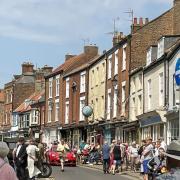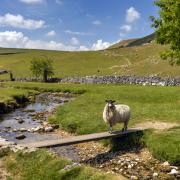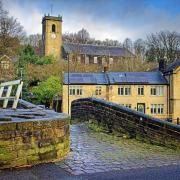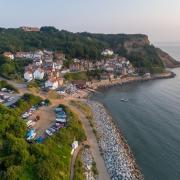Roger Buxton has half-a-century’s commercial and leisure experience of the sea, is a former Commodore of Scarborough Yacht Club, and has been the volunteer LOM (Lifeboat Operations Manager) in charge of Scarborough Lifeboat Station since April 2022.
'I was born in Leeds but when my Dad died when I was four my Mum moved to Scarborough. Mum married a fisherman who really brought me up and I spent all my spare time at the harbour alongside him, hauling lobster pots rather than doing a paper round. Tragically, my stepfather lost his life in a shipwreck.
'After giving up fishing in the early-80s, I worked for a fruit & veg company for a short while, then was installation manager for a sign company and travelled all over the country so couldn’t be actively involved in the RNLI but was always on the periphery, knowing the coxswains etc; I was always there. That image of a lifeboat going down the slipway just enthused me as a child and I’ve never lost that and have retained a lifelong interest in the charity. I took up sailing and yacht racing in the meantime though.

'I’ve been out in all sorts of weather but I’ve been out there because I had to be. The lifeboat crew choose to go. I entered the annual North Sea race from Scarborough to Ijmuiden in Holland but just over halfway across had my rudder fall off. Ijmuiden Lifeboat came to our aid, taking an hour to reach us and eight hours to tow us back through the night. Water was coming into the boat and we were in danger of sinking by the time we reached port. We pumped out, dried out, and then after a couple of days rest set off back. We borrowed an outboard to get us out of the harbour as ours had been submerged. We sailed back, but off Flamborough the wind died and the motor failed. The Coastguard sent Flamborough Lifeboat to tow us into Bridlington. This trip was a perfect illustration of how things can happen.
'On another occasion I was sailing back from Whitby after a race there the previous day. We knew a gale was coming, but thought by setting off early we would be back before it arrived. It arrived early and I fell off the boat. The crew, including my godson, Sam, tried to rescue me several times before finally getting me on the boat, When the Scarborough Lifeboat arrived and assessed me, a helicopter was called due to the time I’d been in the water, so I was airlifted to Scarborough Hospital. That's the only time in my whole seagoing time I thought: ‘This is it; this is how it ends’. Again, it just shows if you spend enough time on the water things will happen to you. Given my own experiences it felt right and proper that I gave something back to the RNLI when the opportunity presented itself.

'Being the LOM is a lot of responsibility but it’s not a chore. I’m proud to be part of an amazing team at Scarborough. We have over 40 in total, a large team within which we have our boat crew, shore crew and ops/launch authority, but not forgetting the vital shop and visitor engagement teams.
' Only five, maybe six, will go out on our Shannon all-weather lifeboat which is a fantastic bit of kit. We also have a D-class which is the in shore workhorse with 22 launches so far this year (Dec 23) against seven for the all-weather.
'Our younger crew members like to be on the D-class as it’s an exhilarating ride but people sign up to do both boats. We wouldn’t want any kind of ‘us and them’ developing between the two crews; we are one team. Whilst there are upper age limits on some RNLI roles such as Launch Authority (70) there isn’t for the LOM as far as I know so I shall carry on as long as I feel able. I feel that age is a number and it’s how your health fares that’s more important.

'The people who volunteer have to be happy. We have to be mindful that they are volunteers and could walk away. At Scarborough we’re lucky to have a great bunch of people. We know why we’re here and what we’re doing it for. It’s not something to brag about, but in your head you just hold that you’re a small part of that amazing set up. There are no egos among them and quite frankly they couldn’t do what they do if they did it for their ego; the weather alone can be enough to knock that. Until you’re in the RNLI you don’t realise what you can get back from it. We ask people to give a lot of that most precious commodity, their time, for example, with training every Tuesday, so people have to feel right about it and we have to look after them”. RNLI lifeboats are no longer a male preserve, with the first woman qualifying to command a lifeboat in 1969. Ladies bring a different dynamic and the team is much better for having them. We have five women, two among the boat crew, two on shore crew, and one on operations/launch authority.
'There are vulnerable people out there on the water and our job is to go and get them. It’s as simple as saving lives at sea; that’s what we do. We do get all sorts, of course, including holidaymakers cut off by the tide, so our water safety team is out there spreading the word. People don’t always get into trouble because they’ve done something wrong. Whenever I was rescued I never thought it would end up like that, but then one thing happens. When I fell off the boat, that was the scariest, but when the lifeboat turns up they sort you out. The training and support is unbelievable these days. Some ‘shouts’ could be traumatic but we have massive support to get us through these. It might not be at the time it hits you, but could creep up on you later'.


‘O hear us when we cry to Thee, For those in peril on the sea’. These words are from the hymn ‘Eternal Father, Strong to Save’ (1860) which is traditionally associated with seafarers, especially in the maritime armed services, but is as resonant for volunteers of the RNLI.
Lifeboats existed before the RNLI, the first purpose-built craft stationed at South Shields in 1790. It was almost another 35 years before the National Institution for the Preservation of Life from Shipwreck was established by Sir William Hillary in March 1824. In 1854 the charity’s name was changed to the Royal National Lifeboat Institution (RNLI) and this year it celebrates its 200th anniversary. The UK’s coastal communities, including Yorkshire’s, know and respect the sea. In peacetime it provides pleasure and sustenance. During wartime it is our ‘moat defensive’, protecting us from foreign foe. During WW1, lifeboats were launched 1,808 times and saved 5,332 lives (1914-18). This heroism was repeated in WW2 when another 6,376 lives were saved (1939-45) with 19 lifeboats helping with the Dunkirk evacuation.
The scale of today’s operation is staggering. RNLI volunteer lifeboat crews and lifeguards saved 506 lives in 2022 alone and helped 39,680 souls. Tragically, around 140 people die annually in UK and Irish coastal waters and the RNLI’s vision is to save every single one of these. The RNLI works with communities and partners to try and prevent people getting into danger in the first place with males over 15 most at risk. It is not just about the crew members braving the waters, of whom only one in ten has a maritime profession, with literally thousands of dedicated fundraisers, and volunteer shore crews helping with launching and recovering lifeboats. There are 238 UK and Irish lifeboat stations covering 19,000 miles of coastline with 441 lifeboats (including relief fleet vessels) and seven hovercraft, whilst RNLI lifeguards patrol 240 UK and Channel Island beaches.



























